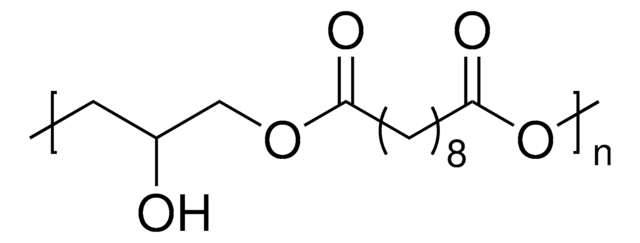推薦產品
一般說明
Poly(caprolactone fumarate) (PCLF) is a crosslinkable, biodegradable polymer consisting of poly(caprolactone) (PCL) and unsaturated fumarate repeating units. This derivative of PCL can be crosslinked to form a three-dimensional polymer network or scaffold. PCLF has been widely investigated for tissue engineering, 3D bioprinting, and drug delivery applications due to its biodegradability, biocompatibility and mechanical performance.
應用
- Tissue engineering including bone and nerve regeneration
- 3D bioprinting
- Drug delivery
Poly(caprolactone fumarate) (PCLF) is a macromonomer consisting of poly(caprolactone) and fumarate repeating units. The bio-compatible poly(capralactone) units shows flexibility and fumarate repeat units provide cross linking ability without adding any toxic cross-linkers
特點和優勢
- Biocompatible
- Crosslinkable via photopolymerization, radical polymerziation, thermal polymereization
- Flexible polymer chain
- Biodegradable via hydrolysis of the ster bonds in both PCL and fumarate segments
儲存類別代碼
10 - Combustible liquids
水污染物質分類(WGK)
WGK 3
閃點(°F)
Not applicable
閃點(°C)
Not applicable
Synthesis, Material Properties, and Biocompatibility of a Novel Self-Cross-Linkable Poly(caprolactone fumarate) as an Injectable Tissue Engineering Scaffold
Esmaiel J. et al.
Biomacromolecules, 6, 2503-2511 (2005)
Synthesis and manufacture of photocrosslinkable poly(caprolactone)-based three-dimensional scaffolds for tissue engineering applications
N. Castro et al.
Advances in Bioscience and Biotechnology, 2, 167-173 (2011)
M Brett Runge et al.
Acta biomaterialia, 8(1), 133-143 (2011-09-14)
Polycaprolactone fumarate (PCLF) is a cross-linkable derivative of polycaprolactone diol that has been shown to be an effective nerve conduit material that supports regeneration across segmental nerve defects and has warranted future clinical trials. Degradation of PCLF (PCLF(DEG)) releases toxic
我們的科學家團隊在所有研究領域都有豐富的經驗,包括生命科學、材料科學、化學合成、色譜、分析等.
聯絡技術服務




